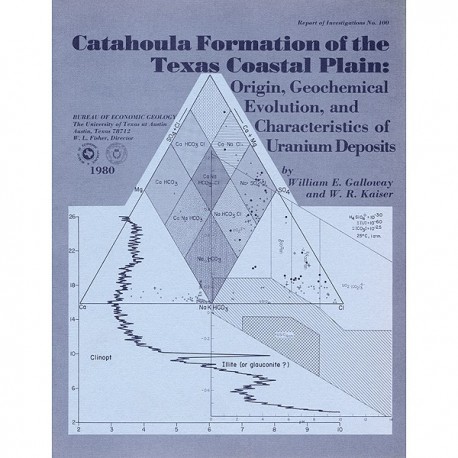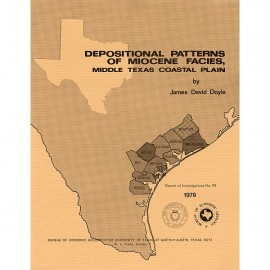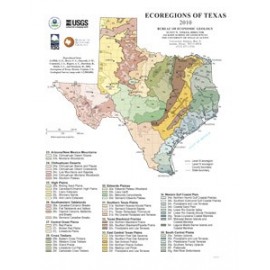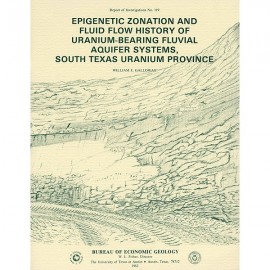Reports of Investigations
-
Books & Reports
- Reports of Investigations
- Guidebooks
- Udden Series
- Geological Circulars
- Down To Earth
- Atlases of Major Oil and Gas Reservoirs
- Texas Memorial Museum Publications
- Environmental Geologic Atlas of the Texas Coastal Zone
- Mineral Resource Circulars
- Other Reports
- Seminars and Workshops
- Handbooks
- Submerged Lands of Texas
- Symposia
- Annual Reports
- Open File Reports
-
Maps & Cross Sections
- Thematic Maps
- Miscellaneous Maps, Charts & Sections
- Geologic Atlas of Texas
- STATEMAP Project Maps
- Geologic Quadrangle Maps
- Cross Sections
- Highway Geology Map
- Energy and Mineral Resource Maps
- Shoreline Change and Other Posters
- Wilcox Group, East Texas, Geological / Hydrological Folios
- Bouguer Gravity Atlas of Texas
- River Basin Regional Studies
- Featured Maps
- Posters
- Teachers & the Public
-
Geological Society Publications
- Gulf Coast Association of Geological Societies
- Alabama Geological Society
- Austin Geological Society
- Corpus Christi Geological Society
- Houston Geological Society
- Lafayette Geological Society
- Mississippi Geological Society
- New Orleans Geological Society
- South Texas Geological Society
- GCS SEPM Publications
- Historic BEG & UT Series
Catahoula Formation of the Texas Coastal Plain: Origin, Geochemical Evolution, and Characteristics of Uranium Deposits
RI0100
Catahoula Formation of the Texas Coastal Plain: Origin, Geochemical Evolution, and Characteristics of Uranium Deposits, by W. E. Galloway and W. R. Kaiser. 81 p., 56 figs., 8 tables, 2 appendices, 1980. ISSN: 0082335X: Print Version.
A free, digital version of this publication can be found on: Texas ScholarWorks
RI0100. Catahoula Formation of the Texas Coastal Plain: Origin, Geochemical Evolution, and Characteristics of Uranium Deposits, by W. E. Galloway and W. R. Kaiser. 81 p., 56 figs., 8 tables, 2 appendices, 1980. ISSN: 0082335X: Print.
To purchase this publication as a downloadable PDF, please order RI0100D.
ABSTRACT
The Catahoula Formation is composed of ancient fluvial sediments that controlled a wide range of water/sediment interactions responsible for uranium mobilization, transportation, and concentration.
Uranium was released from volcanic glass deposited within the Catahoula through early pedogenic and diagenetic processes. Soil development produced plasmic clay cutans, oxide nodules, and vacuoles; open hydrologic system diagenesis produced shard-moldic porosity and clinoptilolite pore-filling cement. Pedogenesis was the most efficient process for mobilizing uranium. Original uranium content in fresh Catahoula glass is estimated to have averaged at least 10 ppm; about 5 ppm was mobilized after deposition and made available for migration. Uranium was transported predominantly as uranyl bicarbonate ion by oxidizing neutral to mildly basic, bicarbonate- and silica-rich ground waters. Uranium transport is continuing today in parts of the Catahoula aquifer in oxidizing (+240to +300 mV) and neutral to highly basic (pH 7 to 11) ground waters. The chemistry of modern Catahoula ground waters reflects down flow ionic evolution and localized mixing with compositionally diverse waters discharged vertically from underlying aquifers.
Chlorinity mapping reveals modern ground-water flow patterns, suggests hydrodynamic interpretation of alteration-front geometry, and provides clues to flow dynamics extant during earlier aquifer evolution.
Isochemical contours reproduce geometries reminiscent of alteration fronts, reveal vertical discharge of saline waters across aquitards and up fault zones, and demonstrate updip movement of sulfide-rich waters apparently intruded into shallow aquifers along faults.
Six uranium deposits representative of the spectrum of Catahoula ores were studied. Uranium-bearing meteoric waters were reduced by reaction with pre-ore stage pyrite formed by extrinsically introduced fault-leaked sulfide (for example, Bruni deposit) or intrinsically by organic matter (for example, Washington-Fayette deposit). Uranium was concentrated in part by adsorption on Ca-montmorillonite cutans, amorphous TiO2, and/ or organic matter followed by uranyl reduction to U4+ in amorphous uranous silicates. Field and geochemical evidence shows that clinoptilolite, a potential adsorber of uranium, is not correlative with mineralization. Calcite is pervasive throughout host sands but shows no spatial or temporal relationship to uranium mineralization.
Waters presently associated with Catahoula uranium deposits are oxidizing, alkaline waters of high ionic strength and are not appropriate models for the primary mineralizing waters, which are postulated to have been reducing, acid waters of low to moderate ionic strength. The presence of marcasite and uranium together at the alteration front strongly supports an acid pH during Catahoula mineralization. Maximum adsorption and minimum solubility of uranium occur at approximately pH 6 in carbonate-rich waters.
Solution and mineral equilibria were used to test activities and mineral saturation against the occurrence of uranium in four deposits. Log activity ratios of individual waters more highly supersaturated with respect to montmorillonite, taken from montmorillonite-clinoptilolite activity diagrams, show a positive correlation with uranium mineralization. High Ca2+, Mg2+, Al(OH)-4, and H+ activities promote the formation of montmorillonite relative to clinoptilolite. High saturation ratios for montmorillonite show fair correlation with mineralization. The mineral-solution equilibria approach is a potential method of geochemical exploration.
Keywords: Catahoula Formation, Texas, Texas Coastal Plain, geochemistry, uranium, Gueydan, Chita-Corrigan, hydrochemistry
Citation
Galloway, W. E., and Kaiser, W. R., 1980, Catahoula Formation of the Texas Coastal Plain: Origin, Geochemical Evolution, and Characteristics of Uranium Deposit: The University of Texas at Austin, Bureau of Economic Geology, Report of Investigations No. 100, 81 p.






